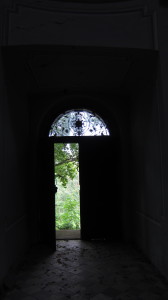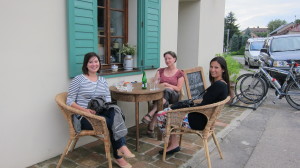-
Off to the Czech Republic
Posted on July 31, 2014This week I had the opportunity to go visit INTO’s newest member the Czech National Trust. The Czech National Trust recently had its official launch earlier this June, and is a part of my case study project for ‘INTO Action’. After all the travel hardships to get from London to Prague, I was on the Tuesday morning train to Kromeriz. Kromeriz is a medieval market town that holds the UNESCO World Heritage site of Kromeriz Castle and the pilot project of the Czech National Trust. Eva Žallmannová, General Director of the Czech National Trust, picked me up from the train station at Hulin and introduced me to Martin Krčma and Andrea Pomajbíková.
They were very gracious with me and toured me around the area, answering my questions and translating the very difficult Czech language while I was there. Also they introduced me to the local culture and food, which was delicious! The three days I was there, I toured the Kromeriz Castle and its garden. The Castle holds English King Charles I art collection, which was purchased by the Archbishop after Charles I was beheaded. The Archbishop took very good care of it. The current renovations of the Walled Garden, which is in the process of being restored to its former glory. I also got the opportunity to tour the Czech National Trust’s Pilot Project, which is the restoration of the tomb of Marie von Ebner-Eschenbach, a Czech feminist writer during the 18th century, whose main works are written in German. The tomb is a beautiful small dome rotunda building that was built on a hill with a great view of the farming landscape of Moravia. Her husband built the tomb for them so they would have an excellent view in death. Morbid, but sweet. The Czech National Trust hopes to restore and preserve this tomb and the surrounding landscape as a place for people to visit and enjoy the country side with a literary twist. The pilot project hopes to be completed by 2016.
After my tour through the countryside of Moravia, I went back to Bohemia and spent the weekend in Prague. After seeing the three important sites of the Astronomical Clock, the Charles Bridge, and the Prague Castle (so many stairs); I toured around the banks of the river with a friend of the Czech National Trust, and she showed me some of the less touristy areas of Prague, which are just as beautiful. One of my favorite museums that I got to visit in Prague was the Museum of Alchemy. These underground tunnels in the Jewish Quarter were discovered after the major flood in 2002. There they found the alchemy laboratories that were funded by Rudolph II and led by Rabbi Levi. The restoration and preservation of the tunnels took a total of ten years to complete. The museum is small, but they did an amazing job on the restoration of tunnels. It was really like stepping back in time to the 16th century when mysticism was still very much alive.
One of my personal interest in the field of historic preservation is the use of heritage sites of nations that have recently come out of isolation. I did not realize what a short time ago that it was the Czech Republic was formed. Technically, I am older than the new nation by almost five years. The current country known as the Czech Republic as only been in existence for 21 years! Yet, the country’s history is incredibly expansive – on one of the tours I went on in Prague, the tour guide stated, “If a person lived in Prague for 75 years starting in 1918, they would have lived under seven different countries/governments without having to move.” So for a city to go through that much change in such a short amount of time it is a miracle that their cultural heritage is still strong.
It was a very educational week about the Czech Republic, which I already did not know much about, and here is a brief summary of some of the things I learned:
- The difference between a chateau and a castle. A chateau is a more livable, comfortable large estate usually decorated in luxury. A castle is more a fortress for protection and less for being comfortable. The Kromeriz Castle is actually chateau even though everyone calls it a castle.
- That gardens are very important heritage locations in the countryside, particularly the planned walled gardens
- The effects of communism on built heritage and life in general particularly out in the countryside
- The effects of the fall of communism on built heritage
- To never underestimate how much energy it takes to climb 288 stairs, and that I need to go to the gym
- That the Czechs are the number one consumers of beer in the world; also realizing I did not enjoy Czech beer as much as I should to fit in 🙂
After a great week, it is back to the UK for the last two weeks…

 44 (0)20 7824 7157
44 (0)20 7824 7157


